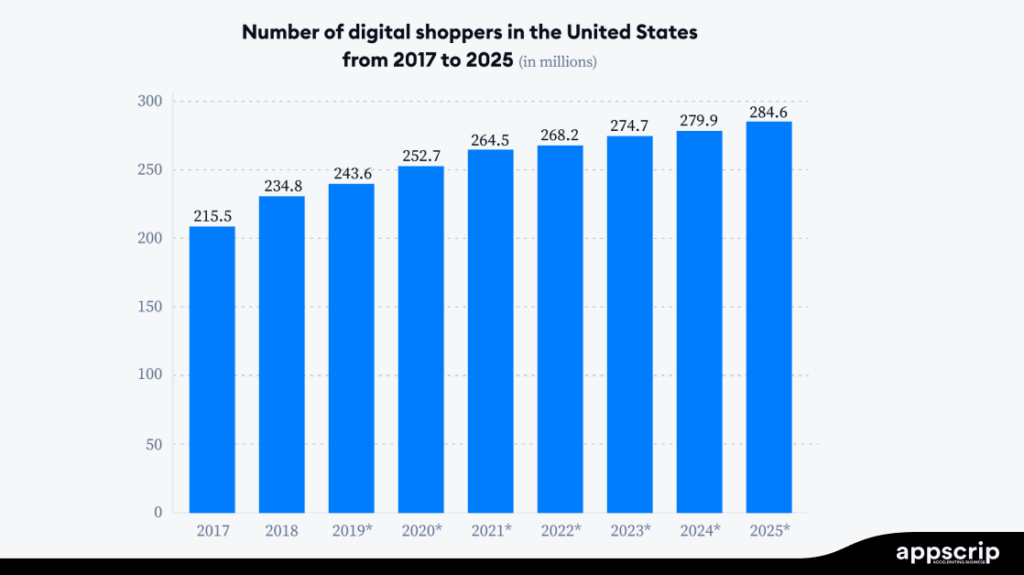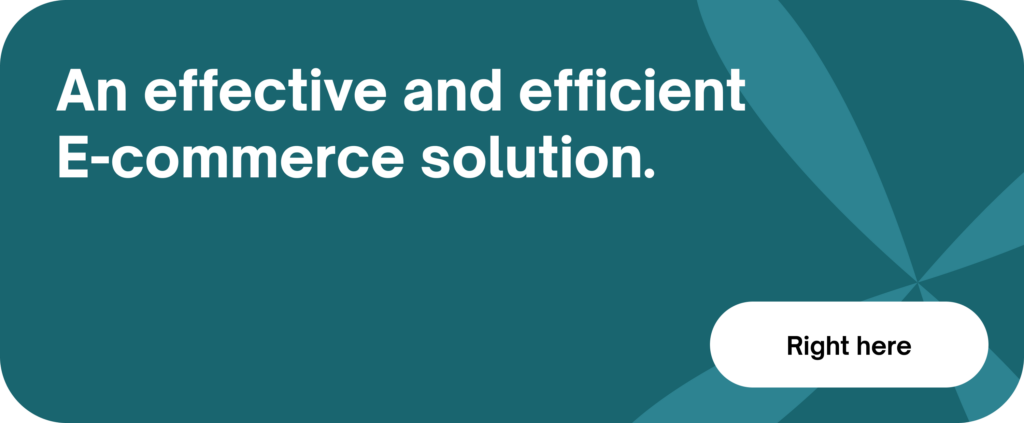The ease, variety, and better discounts offered by online platforms are attracting more and more customers to online shopping, which is driving its rapid expansion. Global ecommerce revenues are projected to hit $8.1 trillion by 2026. Better technology, shifting shopping behavior, and fresh approaches of buying and selling fuel this expansion. Not embracing change could leave your business struggling to stay up, while embracing technology can help you adjust more easily.
So, what’s changing in 2025? The majority of consumers (71%) want brands to cater to their individual preferences when interacting with them. Mobile commerce is thriving, accounting for 72% of all online sales. Today, social media serves as a shopping center and artificial intelligence is changing consumer service and product recommendations.
The key to growth and customer satisfaction for ecommerce businesses is to adapt quickly to these changes. Following these ecommerce trends can help you remain competitive whether you manage a worldwide brand or a local store.
Read this article to learn about the most important ecommerce trends of 2025 and how your business can benefit from them. If you’re looking for solutions to build or enhance your online store, Appscrip provides ecommerce app and website development services that make selling online simpler and more efficient.
Let’s explore the biggest ecommerce trends and strategies for keeping ahead.
TL;DR
- AI-driven recommendations account for nearly 35% of Amazon’s sales, improving engagement and efficiency.
- Voice commerce is expected to reach $40 billion in the U.S. by 2026, making voice search optimization important.
- Augmented reality helps customers see products before buying, reducing uncertainty and returns.
- Social commerce surpassed $1.2 trillion globally in 2024 and is still growing, with TikTok and Instagram leading sales.
- Over 60% of consumers prefer brands with eco-friendly practices, making sustainability a key factor.
- Businesses need to sell across multiple platforms, improve customer experiences, and offer smooth payment options.
- Appscrip provides ecommerce development solutions with AI-powered recommendations, social commerce integration, and seamless checkout to help businesses grow.
The Biggest Ecommerce Trends in 2025 & Beyond
AI-Powered Shopping and Personalization
Shoppers want an experience that feels tailored just for them, and AI is making that happen. Smart recommendations, chatbots, and predictive analytics are helping businesses connect with customers in a whole new way. 71% of shoppers expect brands to personalize their experience. Companies like Amazon have seen a 35% increase in sales by using AI-powered recommendations.
- AI chatbots answer questions instantly, reducing wait times and improving customer experience.
- Predictive analytics help stores stock up on popular items and create targeted promotions.
- AI-driven email campaigns get 41% more clicks than traditional ones.
Mobile Commerce Growth
People are glued to their phones, and they’re using them to shop more than ever. Mobile commerce now makes up 72% of all online sales. A slow, clunky website will not be of much use anymore. 80% of shoppers leave sites that don’t work well on mobile.
- Fast-loading, mobile-friendly websites improve engagement.
- One-click purchasing speeds up checkout and reduces cart abandonment.
- Mobile apps encourage repeat shopping. Walmart saw mobile sales jump 98% after improving its app.
Social Media as a Shopping Hub
Scrolling through social media is not just for entertainment. It has become a shopping platform too. TikTok Shop and Instagram Checkout let users buy products without leaving the app. 50% of Gen Z shoppers prefer finding products on social media instead of search engines.
- Brands are selling directly through social platforms.
- Live shopping events drive engagement and increase sales.
- Influencer partnerships help businesses reach new audiences. Nike’s TikTok Live shopping event led to a 45% jump in sales.
Sustainability and Ethical Shopping
Shoppers are more eco-conscious, and they’re putting their money where their values are. Over 60% of consumers are willing to pay more for sustainable products. Businesses that offer recyclable packaging, carbon-neutral shipping, and responsibly sourced products are winning customer trust.
- Using biodegradable materials improves brand perception.
- Ethical sourcing attracts shoppers who value sustainability.
Flexible Payment Options
Customers love having choices, and that includes how they pay for their purchases. Buy Now, Pay Later (BNPL), digital wallets, and even cryptocurrency are becoming the norm. BNPL services have skyrocketed, growing by 85% since 2020, with Affirm and Klarna leading the way.
- BNPL makes shopping easier for budget-conscious buyers.
- Digital wallets like Apple Pay and Google Pay provide fast and secure checkouts.
- Secure payment options build trust and increase conversions. Shopify increased cart conversions by 36% after adding BNPL options.
Augmented Reality (AR) Shopping
Online shopping is getting more interactive with AR. 61% of shoppers prefer stores that offer AR experiences. Virtual try-ons help customers feel more confident before they buy, which means fewer returns.
- IKEA’s Place app lets shoppers see how furniture looks in their home before buying.
- Sephora’s Virtual Artist allows customers to test makeup shades on their phones.
- Nike’s AR shoe sizing tool reduced returns by 20%, making online shoe shopping easier.
Automated Warehousing and Smart Logistics
Fast shipping is no longer a luxury but an expectation from the customers. By the end of 2025, 85% of ecommerce warehouses will use AI-powered automation.
- AI predicts demand to prevent stock shortages.
- Fulfillment centers with fast shipping improve customer satisfaction.
- Automation reduces errors and speeds up delivery. Amazon’s robotic warehouses have reduced processing time by 50%.

Challenges and Solutions in Ecommerce Growth
As ecommerce grows, businesses must navigate challenges that can slow them down. Understanding these obstacles and taking the right steps to address them can help businesses stay competitive and continue to grow.
Data Privacy and Security Concerns
With more people shopping online, businesses are handling a growing amount of customer data. Protecting this information is essential, as any security breach can damage trust and lead to financial losses. To prevent this, businesses should use strong encryption to safeguard sensitive data and comply with regulations like GDPR and CCPA to avoid legal complications.
Secure payment methods and fraud detection systems add another layer of protection, ensuring that customers feel safe when making transactions. Regular security checks also help identify and fix weaknesses before they become serious problems.
Supply Chain Disruptions
Keeping products in stock and delivering them on time has become more challenging due to supply chain disruptions. Factors such as shipping delays, inventory shortages, and production issues can result in late deliveries and unhappy customers.
To minimize these risks, businesses should work with multiple suppliers to avoid reliance on a single source. AI-based forecasting tools can help predict demand and ensure the right products are stocked. Using local warehouses allows for faster delivery, while providing tracking updates keeps customers informed and reassured about their orders.
For faster delivery of fresh seafood products, fish processing plants can be included into the supply chain. Professional services automation software can streamline coordination across supply chain processes.
Rising Customer Expectations
Shoppers today expect fast shipping, smooth checkout processes, and hassle-free returns. Businesses that fail to meet these expectations may struggle to retain customers. To improve service, automated chat support can provide quick answers and assistance, reducing customer frustration.
Flexible return policies encourage shoppers to complete purchases, knowing they can easily return items if needed. Order tracking keeps customers updated on their deliveries, reducing uncertainty and complaints. A well-optimized website with a fast checkout process also helps reduce cart abandonment and improves the overall shopping experience.
Competition from Marketplaces
Large platforms like Amazon and eBay dominate the online shopping space, making it difficult for smaller businesses to stand out. To compete effectively, businesses need to build a strong brand identity that attracts and retains loyal customers. Offering unique or custom products gives shoppers a reason to choose independent stores over big marketplaces.
Digital marketing and SEO strategies help improve visibility, making it easier for customers to find products. Implementing loyalty programs and offering personalized deals can also strengthen customer relationships and encourage repeat purchases.
Adapting to Emerging Technologies
Technology is changing how people shop, and businesses need to keep up to stay relevant. AI tools can streamline customer service, making interactions faster and more efficient. Augmented reality (AR) features allow shoppers to see how products look before buying, reducing uncertainty and improving confidence in purchases. Staying informed about new technology trends ensures businesses are prepared for future advancements and can integrate them seamlessly into their operations.
How Businesses Can Stay Ahead in Ecommerce
As competition grows, businesses must stay flexible and find ways to stand out. Keeping up with trends, improving the customer experience, and using the right tools will help businesses stay ahead. Here are some key strategies for staying competitive.
Prioritizing Customer Experience
A seamless and enjoyable shopping experience keeps customers coming back. Businesses that invest in improving every stage of the customer journey, from browsing to checkout, see higher retention rates and brand loyalty.
- Improve website performance for fast and smooth browsing. Slow-loading pages can cause frustration and lead to cart abandonment.
- Offer multiple payment options, including credit cards, digital wallets, and Buy Now, Pay Later (BNPL) services, to give customers flexibility.
- Use AI-powered chatbots to assist customers with common questions and provide instant support, reducing wait times and improving satisfaction.
- Investing in reliable Magento hosting for ecommerce ensures a seamless and enjoyable shopping experience for customers.
- Provide detailed product descriptions, high-quality images, and customer reviews to reduce uncertainty and increase confidence in purchases.
- Offer hassle-free return policies that give customers peace of mind when making a purchase.
- Personalize the shopping experience by suggesting products based on previous browsing and purchasing behavior.
- Use solutions like Appscrip’s ecommerce app development services to create seamless shopping experiences tailored to business needs.
Using Data to Make Smart Decisions
Understanding customer preferences and shopping behaviors helps businesses refine their strategies. Data analytics can reveal trends, popular products, and areas that need improvement, leading to smarter business decisions.
- Track customer behavior to determine which products perform well and which need improvement.
- Use past sales data to manage inventory more efficiently and prevent stock shortages or overstocking.
- Analyze customer feedback to identify areas for better service and product enhancements.
- Personalize promotions and discounts based on individual shopping habits to increase engagement and sales.
- Implement A/B testing to improve website layout, product placement, and marketing campaigns.
- Use integrated solutions like analytics tools to streamline decision-making and optimize store performance.
Expanding Sales Channels
Selling through multiple platforms increases visibility and revenue. Businesses that only rely on one sales channel risk missing out on potential customers. Expanding into social media, online marketplaces, and mobile apps helps attract a broader audience.
- List products on major marketplaces like Amazon, eBay, and Walmart to tap into their large customer bases.
- Use social media platforms like Instagram, Facebook, and TikTok to showcase products and engage directly with customers.
- Develop a mobile app that provides a convenient shopping experience, exclusive deals, and personalized recommendations.
- Partner with influencers and content creators to promote products to their followers and expand brand reach.
- Implement a subscription-based model for repeat customers, offering discounts or exclusive perks.
- Work with Appscrip’s ecommerce app development solutions to build a user-friendly mobile shopping platform that enhances customer engagement.
Streamlining Operations with Technology
Automation and technology improve efficiency, reduce errors, and enhance customer satisfaction. Businesses that embrace digital tools can optimize their operations and focus on growth.
- Use AI for inventory forecasting and demand planning to ensure products are stocked according to customer needs.
- Implement automated order processing and fulfillment systems to speed up deliveries and reduce human errors.
- Adopt customer service chatbots that handle common inquiries 24/7, allowing human agents to focus on complex issues.
- Integrate Augmented Reality (AR) features that allow customers to try on products virtually, improving confidence in purchases and reducing returns.
- Utilize warehouse robotics to speed up order packing and shipping, ensuring fast and accurate deliveries.
- Use blockchain technology for secure and transparent transactions, improving trust and reducing fraud risks.
Focusing on Sustainability
Consumers are becoming more conscious of how businesses impact the environment. Companies that adopt sustainable practices not only reduce their carbon footprint but also attract customers who prefer eco-friendly brands.
- Use recyclable or biodegradable packaging to minimize waste and appeal to environmentally aware customers.
- Offer carbon-neutral shipping options by partnering with logistics providers that invest in sustainable delivery practices.
- Work with ethical suppliers that follow fair labor practices and use sustainable materials.
- Promote sustainability initiatives through marketing campaigns and product labeling, making it easier for customers to choose eco-friendly options.
- Encourage customers to recycle by offering incentives such as discounts or rewards for returning used products.
- Implement energy-efficient processes in warehouses and offices to reduce operational costs while minimizing environmental impact.
The Future of Ecommerce
Businesses who keep up with the latest developments in the ecommerce space will have an advantage compared to the competition. Online shopping is becoming more user-friendly thanks to AI-powered solutions, which also enable companies to automate services, track consumer behavior, and predict purchasing habits. Businesses like Amazon and Shopify personalize experiences and increase sales with AI recommendations.
Alexa and Google Home have greatly improved the purchasing experience, leading to an increase in voice commerce. Major stores already using voice shopping are anticipated to bring in $40 billion in the United States by 2026. Also, with the help of augmented reality (AR), customers can see what they’re getting before they buy it online, which eliminates guesswork and returns. IKEA and Sephora have already adopted AR to enhance shopping experiences.
Social media platforms are becoming important ecommerce hubs, with live shopping and influencer marketing promoting direct sales.
E-commerce has an interesting future; companies which keep up with evolving consumer expectations and technology will see actual expansion. Businesses that want to remain competitive must provide customers with enjoyable and easy purchasing experiences. For an online store to be successful, it needs a user-friendly design, many sales channels, and safe payment methods.
That’s where Appscrip can help. Our ecommerce app development solutions are designed to give businesses the support they need to succeed. From AI-powered product recommendations to seamless transaction experiences, our solutions assist businesses to maximize engagement and improve conversion rates. Moreover, built-in social commerce integration and advanced analytics let ecommerce businesses easily monitor performance and refine their strategies.
If you’re looking for a way to scale your online store and stay ahead of ecommerce trends, Appscrip has the right tools to make it happen. Get in touch right now to find out how our solutions could reinvent your ecommerce business.
FAQs
What role does social commerce play in ecommerce growth?
Social commerce is turning platforms like TikTok and Instagram into shopping hubs. People can discover products, watch live shopping events, and buy without leaving their favorite apps, making shopping feel more interactive and fun.
How is sustainability influencing ecommerce trends?
Shoppers are looking for brands that care about the planet. More businesses are using eco-friendly packaging, offering carbon-neutral shipping, and making sure their products come from ethical sources to meet growing demand.
Why is mobile commerce growing so fast?
Everyone shops on their phones now. Fast-loading mobile websites, one-click checkouts, and payment options like Apple Pay and BNPL make it easier than ever to buy on the go.
What is the ecommerce trend?
AI-driven personalization, mobile shopping, social commerce, and sustainability are shaping eCommerce. Customers expect fast delivery, easy checkout, and a shopping experience tailored to their needs.
What is the trend in ecommerce in 2025?
AI, AR, and automation are taking over. More businesses are using smart tools to personalize experiences, voice shopping is becoming mainstream, and eco-friendly practices are now expected rather than optional.
What is the future for ecommerce?
Ecommerce will keep getting faster, smarter, and more personalized. AI-powered shopping assistants, data-driven marketing, and advanced logistics will make buying online even more easy and accessible.
What are the challenges in ecommerce?
Businesses have to deal with tough competition, supply chain issues, cybersecurity risks, and ever-changing customer expectations. To stay ahead, they need fast shipping, secure payments, and a smooth online experience.






